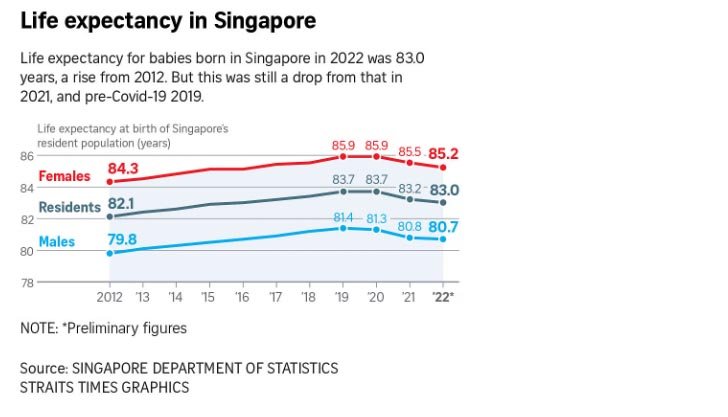May 23, 2023
SINGAPORE – Life expectancy in Singapore has improved over the last 10 years (2012 to 2022), except for the period between 2020 and 2022, which was affected by the Covid-19 pandemic.
The fall in life expectancy in 2021 – the first since such figures were made available more than 60 years ago – was due to higher mortality rates resulting from Covid-19.
In 2020, life expectancy at birth was 83.7 years. It dropped to 83.2 years in 2021, and then to 83 in 2022.
The higher mortality rates that led to a fall in life expectancy at birth in 2020 and 2021 were caused by excess deaths during the pandemic.
The term “excess deaths” refers to the difference between the actual number of deaths from all causes since the pandemic began and the expected number of deaths if there had been no pandemic.
The data was from the Complete Life Tables for Singapore Resident Population 2021-2022, an annual publication by the Department of Statistics (DOS). It was released on Monday.
Life expectancy for babies born in Singapore in 2022 was 83 years, an improvement of 0.9 years from 82.1 years in 2012. This was still a decline of 0.2 years from 83.2 years in 2021, and 0.7 years from 83.7 years in pre-pandemic 2019.
This is the first decline in life expectancy at birth since 1957, the earliest year in which such data was available.
The expected survival rates of newborns in Singapore continued to improve in general over the past decade. The male and female life expectancies at birth were 80.7 years and 85.2 years, respectively, in 2022, an improvement of 0.9 years over the 10 years.
In 2022, 89.4 per cent of newborn boys were expected to be alive at age 65, up from 88.2 per cent in 2012, while 94 per cent of girls born in 2022 were expected to be alive at age 65, up from 93 per cent in 2012.

Similarly, life expectancy at age 65 went up by 0.5 years over the last 10 years, to 20.7 years in 2022. But this was a drop of 0.2 years from 20.9 years in 2021.
According to the DOS report, the life expectancy data for 2020 to 2022 assumed that the higher mortality rates during the pandemic would apply throughout a lifetime, and they might not be representative of the number of years people can expect to live, if mortality rates were to return to pre-pandemic levels.

